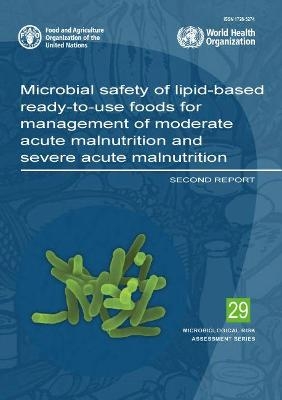
Microbial safety of lipid-based ready-to-use foods for management of moderate acute malnutrition and severe acute malnutrition
second report
Seiten
2021
Food & Agriculture Organization of the United Nations (FAO) (Verlag)
978-92-5-133930-5 (ISBN)
Food & Agriculture Organization of the United Nations (FAO) (Verlag)
978-92-5-133930-5 (ISBN)
Reviews the status of the microbiological safety of lipid-based ready-to-use foods (RUFs) and provides guidance to producers on the general approach and requirements for manufacturing RUFs that are safe for their intended use.
Lipid-based ready-to-use foods (RUFs) for the nutritional management of moderate acute malnutrition (MAM) and severe acute malnutrition (SAM) are provided to children from 6 months to 59 months of age within the context of emergency feeding programmes supervised by governments. Based on the review, the expert committee considered that children with SAM have an increase in susceptibility to bacteraemia and sepsis that is probably between twofold and fivefold compared with children who are not malnourished and are of the same age and live in the same communities. On the basis of its common occurrence as a cause of infections and serious illnesses in children with SAM, and its documented ability to contaminate, survive in, and cause outbreaks of illness associated with low-moisture foods similar to RUFs, the expert committee concluded that Salmonella is the pathogen of most concern in lipid-based RUFs. Many outbreaks of foodborne salmonellosis have been determined to be associated with low-moisture foods that were contaminated at low levels. Therefore, the expert committee carefully considered the qualitative microbiological analyses of RUFs and the contamination levels that could be inferred, and entered into an extended deliberation of dose-response modelling to find a path toward a reasonable approximation of the likely morbidity and mortality in SAM children that could be anticipated from consumption of RUFs contaminated at the estimated levels and observed frequency. The expert committee described three approaches that purchasers of RUFs might use to establish microbiological criteria to assure the safety of RUFs and to communicate to manufacturers their safety expectations. These approaches are: (i) reference to existing standards established for similar low-moisture foods; (ii) determining an acceptable increase in risk over the pre-existing baseline of illness from other sources of exposure; and (iii) process verification sampling using the moving window technique. The microbiological criteria derived by each of these approaches accomplish different purposes, and which is most appropriate is determined by the conditions of manufacture and use
Lipid-based ready-to-use foods (RUFs) for the nutritional management of moderate acute malnutrition (MAM) and severe acute malnutrition (SAM) are provided to children from 6 months to 59 months of age within the context of emergency feeding programmes supervised by governments. Based on the review, the expert committee considered that children with SAM have an increase in susceptibility to bacteraemia and sepsis that is probably between twofold and fivefold compared with children who are not malnourished and are of the same age and live in the same communities. On the basis of its common occurrence as a cause of infections and serious illnesses in children with SAM, and its documented ability to contaminate, survive in, and cause outbreaks of illness associated with low-moisture foods similar to RUFs, the expert committee concluded that Salmonella is the pathogen of most concern in lipid-based RUFs. Many outbreaks of foodborne salmonellosis have been determined to be associated with low-moisture foods that were contaminated at low levels. Therefore, the expert committee carefully considered the qualitative microbiological analyses of RUFs and the contamination levels that could be inferred, and entered into an extended deliberation of dose-response modelling to find a path toward a reasonable approximation of the likely morbidity and mortality in SAM children that could be anticipated from consumption of RUFs contaminated at the estimated levels and observed frequency. The expert committee described three approaches that purchasers of RUFs might use to establish microbiological criteria to assure the safety of RUFs and to communicate to manufacturers their safety expectations. These approaches are: (i) reference to existing standards established for similar low-moisture foods; (ii) determining an acceptable increase in risk over the pre-existing baseline of illness from other sources of exposure; and (iii) process verification sampling using the moving window technique. The microbiological criteria derived by each of these approaches accomplish different purposes, and which is most appropriate is determined by the conditions of manufacture and use
| Erscheinungsdatum | 19.04.2021 |
|---|---|
| Reihe/Serie | Microbiological risk assessment series ; 29 |
| Verlagsort | Rome |
| Sprache | englisch |
| Themenwelt | Naturwissenschaften ► Biologie ► Mikrobiologie / Immunologie |
| Technik | |
| ISBN-10 | 92-5-133930-9 / 9251339309 |
| ISBN-13 | 978-92-5-133930-5 / 9789251339305 |
| Zustand | Neuware |
| Haben Sie eine Frage zum Produkt? |
Mehr entdecken
aus dem Bereich
aus dem Bereich
Allgemeine Grundlagen und spezielle Anwendungen
Buch | Softcover (2021)
Springer Berlin (Verlag)
CHF 76,95


